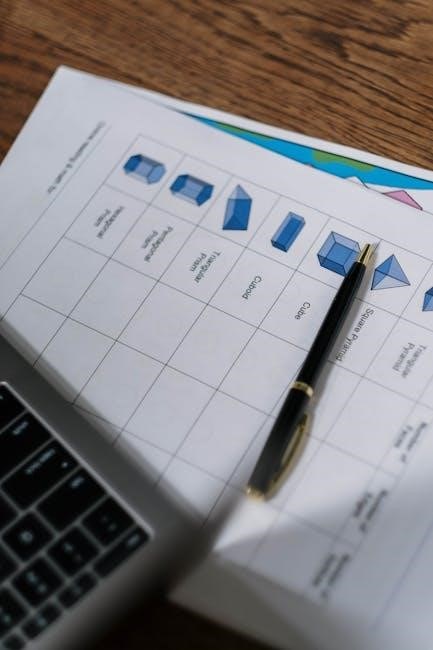Cognitive Behavioral Therapy (CBT) for psychosis is a structured, evidence-based approach to managing symptoms like delusions and hallucinations. It helps individuals understand and challenge unhelpful thoughts and behaviors, promoting emotional well-being and daily functioning. CBT for psychosis is often used alongside medication and focuses on addressing distressing symptoms through practical techniques.

Role of Worksheets in CBT
CBT worksheets provide a structured framework for learning and applying therapeutic techniques. They help individuals track progress, identify patterns, and develop coping strategies for managing psychotic symptoms effectively.

2.1 Teaching About Psychosis
Worksheets play a crucial role in educating individuals about psychosis, its symptoms, and underlying causes. They help users gain insight into how their thoughts, feelings, and behaviors are interconnected. By completing these tools, individuals can identify triggers and understand cognitive distortions contributing to their symptoms. Worksheets also introduce key concepts of CBT, such as challenging unhelpful beliefs and restructuring negative thought patterns. This foundational knowledge empowers individuals to take an active role in managing their condition. Educational exercises often include symptom monitoring, thought recording, and activities that promote self-awareness and understanding of psychosis.
2.2 Identifying Triggers
Worksheets are essential for identifying triggers that may contribute to psychotic symptoms. They guide individuals in tracking specific events, emotions, or situations that precede episodes. By documenting these patterns, users can recognize common triggers, such as stress, sleep deprivation, or certain environments. These exercises help individuals understand how triggers impact their thoughts and behaviors, enabling them to develop strategies to manage or avoid them. Identifying triggers is a critical step in CBT for psychosis, as it empowers individuals to anticipate and prepare for challenging situations, reducing the intensity of symptoms and improving overall well-being.

Common Worksheets
Common worksheets include Thought Logs, Activity Monitoring, Problem-Solving, and Cognitive Restructuring. These tools help individuals track thoughts, behaviors, and emotions, fostering insight and coping strategies.
3.1 Thought Logs
Thought Logs are essential tools in CBT for psychosis, enabling individuals to track and analyze their thoughts, emotions, and behaviors. These worksheets help identify patterns and triggers, promoting self-awareness. By documenting specific situations, thoughts, and resulting feelings, users can challenge and reframe unhelpful cognitive distortions. Thought Logs are particularly useful for managing delusions and hallucinations, as they encourage objective reflection. Regular use fosters a better understanding of symptoms and enhances coping strategies, making them a cornerstone of CBT interventions for psychosis. They are often provided as downloadable PDFs, offering a structured format for consistent practice and progress tracking.
3.2 Activity Monitoring
Activity Monitoring worksheets are valuable tools in CBT for psychosis, helping individuals track their daily activities and their impact on mental state. These logs enable users to identify patterns, such as how specific tasks or events influence their thoughts, emotions, and symptoms. By documenting activities, individuals can better understand triggers and develop strategies to manage them. Activity Monitoring also helps improve motivation and engagement in meaningful routines, which can enhance overall well-being. Many CBT worksheets for psychosis, including Activity Monitoring forms, are available as downloadable PDFs, making it easy to use them consistently and effectively in therapy or self-management programs.
3.3 Problem-Solving
Problem-Solving worksheets in CBT for psychosis guide individuals in addressing challenges systematically. These tools help users define problems, generate solutions, and evaluate their effectiveness. By breaking down complex issues into manageable steps, individuals can develop practical strategies to cope with distressing symptoms or life difficulties. Worksheets often include sections for brainstorming, pros-and-cons analysis, and action planning. This structured approach fosters independence and confidence, enabling individuals to tackle problems more effectively. Many CBT worksheets for psychosis, including problem-solving exercises, are available as downloadable PDFs, making them accessible for both therapists and individuals to use in treatment or self-help programs.
3.4 Cognitive Restructuring
Cognitive Restructuring worksheets are essential tools in CBT for psychosis, helping individuals identify and challenge unhelpful or distorted thought patterns. These exercises guide users to examine evidence for and against their beliefs, fostering a more balanced perspective. By restructuring delusional or distressing thoughts, individuals can reduce emotional distress and improve coping strategies. Worksheets often include steps to identify triggers, assess thought accuracy, and develop more realistic interpretations. This technique empowers individuals to manage psychotic symptoms effectively and regain control over their thoughts. Many cognitive restructuring worksheets are available as free PDF downloads, offering practical support for both therapy and self-management.

How to Use Worksheets
Start by identifying triggers and completing thought logs. Regularly review progress, and seek guidance from therapists. Consistency and patience are key to effective worksheet use.
4.1 Step-by-Step Guide
Identify Goals: Determine what you aim to achieve with the worksheet, such as understanding triggers or restructuring thoughts.
Complete Sections: Fill in each section thoroughly, reflecting on experiences and emotions.
Review Progress: Regularly go over completed worksheets to track changes and improvements.
Seek Feedback: Discuss insights with a therapist or trusted individual for deeper understanding.
Practice Consistency: Use worksheets regularly to reinforce learning and maintain progress.
Reflect and Adjust: Adapt strategies based on what works best for your unique situation.
4.2 Tips for Effectiveness
Consistency is key—regular use of worksheets helps reinforce new skills and perspectives. Start with simple exercises and gradually tackle more complex ones. Be patient with yourself, as progress may take time. Maintain a non-judgmental attitude while exploring thoughts and emotions. Use worksheets in a quiet, distraction-free environment to enhance focus. Review and reflect on completed exercises to identify patterns and growth areas. Incorporate feedback from therapists or support systems to deepen understanding. Celebrate small successes to stay motivated. Remember, the goal is not perfection but meaningful progress in managing symptoms and improving well-being.

Free PDF Resources
Several free PDF resources are available for CBT for psychosis worksheets, offering practical tools to manage symptoms. The Think CBT Workbook is a popular choice, providing structured exercises to track thoughts and behaviors. Additionally, NHS therapy resources include downloadable worksheets for cognitive restructuring and activity monitoring. Websites like Therapist Aid and CBT Worksheets offer customizable templates to suit individual needs. These resources are designed to be user-friendly, helping individuals develop coping strategies and monitor progress. They are ideal for both self-help and guided therapy, ensuring accessible support for managing psychosis effectively.

Benefits and Effectiveness
CBT for psychosis has proven to be highly effective in reducing symptoms like hallucinations and delusions. It helps individuals identify and challenge unhelpful thought patterns, improving emotional regulation and daily functioning. Studies show significant improvements in overall psychotic symptoms, with benefits lasting long-term. CBT empowers individuals by teaching practical skills to manage distressing experiences, fostering independence and confidence. The structured approach of CBT worksheets enhances engagement, making therapy more accessible and impactful. By addressing both positive and negative symptoms, CBT for psychosis offers a comprehensive and evidence-based solution for achieving mental well-being.

Limitations and Challenges
While CBT for psychosis is effective, it has limitations. Some individuals may not experience significant symptom reduction, as results can vary. Engagement and motivation are crucial, requiring consistent effort from both clients and therapists. The complexity of psychotic symptoms can make it challenging to identify and challenge unhelpful thought patterns. Additionally, the effectiveness of worksheets depends on proper implementation and individual tailoring. Therapists need specialized training to deliver CBT for psychosis effectively. Limited accessibility to trained professionals and the need for ongoing practice to maintain progress are notable challenges. Despite these limitations, CBT remains a valuable tool for managing psychotic symptoms when implemented correctly.

Integration into Practice
Integrating CBT for psychosis worksheets into clinical practice enhances structured and goal-oriented therapy sessions. Clinicians can use these tools to guide clients in identifying triggers, restructuring thoughts, and monitoring activities. Worksheets serve as visual aids, helping clients track progress and gain insights into their symptoms. Therapists can tailor worksheets to individual needs, ensuring relevance and engagement. Regular use of these resources fosters a collaborative therapeutic relationship, empowering clients to take an active role in their recovery. By incorporating worksheets into practice, clinicians can streamline therapy processes and ensure consistent, evidence-based interventions for managing psychosis effectively.

Troubleshooting Common Issues
Common challenges when using CBT for psychosis worksheets include clients finding them too vague or rigid. Some may struggle with understanding exercises or completing tasks. Clinicians can address this by providing clear examples and allowing customization. Non-compliance can be tackled by exploring barriers and simplifying tasks. Ensuring worksheets are relevant to the client’s experience improves engagement. Regular feedback and collaborative problem-solving help overcome obstacles, making therapy more effective and client-centered. By addressing these issues proactively, clinicians can enhance the utility of worksheets and promote better client outcomes in managing psychosis symptoms.
CBT for psychosis worksheets are invaluable tools for managing symptoms and improving mental health. They provide structured exercises to identify triggers, challenge unhelpful thoughts, and develop coping strategies. Free PDF resources, such as thought logs and activity monitoring sheets, are widely available, making CBT accessible to everyone. These worksheets empower individuals to take control of their symptoms and work toward recovery. By integrating CBT techniques into daily life, clients can achieve long-term improvement and enhanced well-being. The effectiveness of CBT for psychosis is well-documented, making these worksheets a essential resource for both clinicians and individuals seeking to manage psychotic symptoms effectively.
